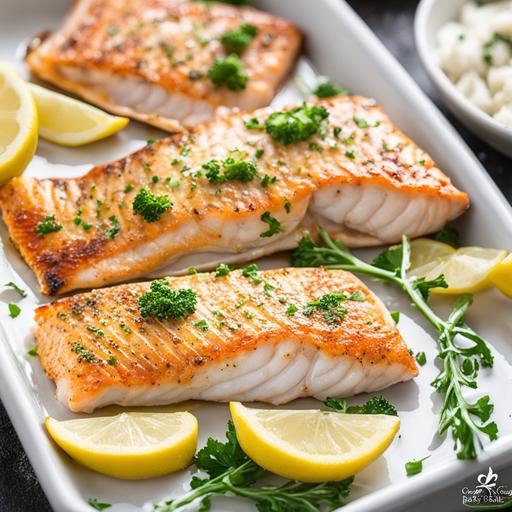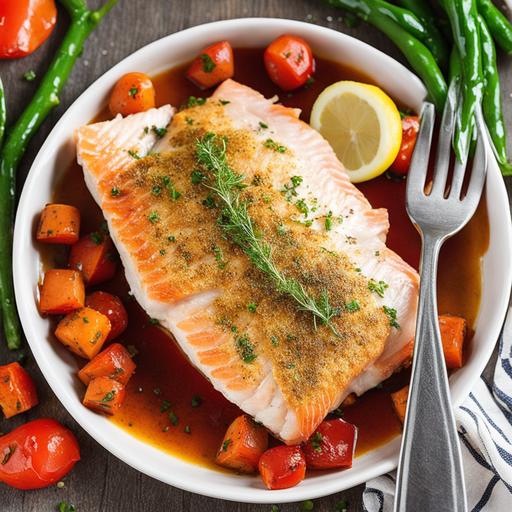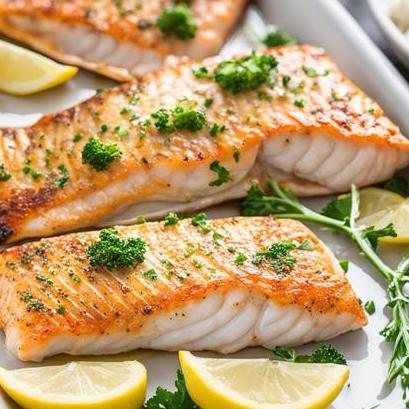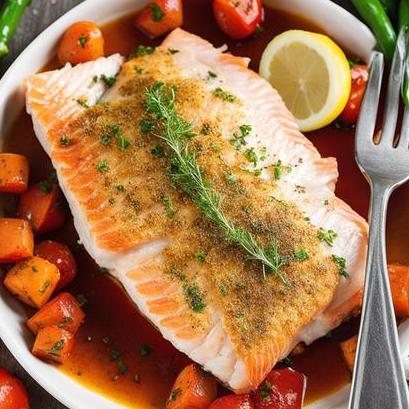
Rockfish Fillets: An Oven Recipe To Savor
Rockfish fillets are a delicious and versatile seafood option that can be prepared in various ways. One popular method is baking them in the oven, which results in tender, flavorful fish that is perfect for any occasion. In this comprehensive guide, we will explore the science behind cooking rockfish fillets in the oven, discuss the importance of choosing the right ingredients, provide detailed instructions for preparing the fish, and share a mouthwatering oven recipe to delight your taste buds.
Food Science Of Cooking Rockfish Fillets In An Oven
Cooking rockfish fillets in the oven involves a delicate balance of temperature and timing to ensure that the fish is cooked evenly and retains its moisture and flavor. The process relies on principles of heat transfer and protein denaturation to transform raw fish into a delectable dish.
When rockfish fillets are exposed to heat in the oven, several chemical reactions occur. Proteins in the fish begin to denature, causing them to unfold and reorganize. This process results in the firming of the flesh and the development of a desirable texture. Additionally, Maillard browning reactions take place, leading to the formation of flavorful compounds that enhance the taste of the fish.
The key to successful oven cooking lies in controlling the temperature to avoid overcooking or undercooking the fish. Too high a temperature can cause the fillets to become dry and tough, while insufficient heat may result in raw or undercooked fish.
Choosing Ingredients
Selecting high-quality ingredients is essential for achieving the best results when cooking rockfish fillets in the oven. When choosing your fish, look for fillets that are fresh, firm, and free from any unpleasant odors. Ideally, opt for wild-caught rockfish for superior flavor and sustainability.
In addition to the fish itself, consider the accompanying ingredients that will enhance the flavor of your dish. Fresh herbs such as parsley, dill, or thyme can add brightness and aroma, while citrus fruits like lemon or lime can provide a refreshing acidity. Olive oil, butter, or a combination of both can be used to add richness and moisture to the fish.
Preparing Ingredients

Proper preparation of the ingredients is crucial for ensuring that your rockfish fillets turn out perfectly cooked and flavorful. Follow these steps to prepare your fish for the oven:
-
Thawing: If using frozen rockfish fillets, thaw them thoroughly in the refrigerator overnight. This slow thawing process helps preserve the texture and moisture of the fish.
-
Trimming: Remove any excess skin or bones from the fillets using a sharp knife. Trim off any dark or discolored portions of the flesh to ensure a clean presentation.
-
Seasoning: Season the fillets generously with salt and pepper, as well as any additional herbs or spices of your choice. Be sure to coat both sides of the fish evenly for maximum flavor.
-
Marinating (optional): For added flavor, consider marinating the rockfish fillets in a mixture of olive oil, citrus juice, garlic, and herbs for 30 minutes to an hour before cooking. This step is optional but can enhance the taste and tenderness of the fish.
Optimal Oven Cooking Temperature & Timing
Achieving the perfect oven temperature and cooking time is essential for ensuring that your rockfish fillets are cooked to perfection. Follow these guidelines for optimal results:
-
Preheat the Oven: Before placing the fillets in the oven, preheat it to 375°F (190°C) for a conventional oven or 350°F (175°C) for a convection oven. This ensures even cooking and reduces the risk of overcooking.
-
Cooking Time: The cooking time for rockfish fillets will vary depending on their thickness. As a general rule of thumb, cook the fish for 10-12 minutes per inch of thickness. For example, if your fillets are 1 inch thick, they will require approximately 10-12 minutes of cooking time.
-
Checking for Doneness: To determine if the fillets are cooked through, use a fork to gently flake the flesh. The fish should be opaque and easily flake apart, with an internal temperature of 145°F (63°C). Avoid overcooking the fish, as this can result in dryness and loss of flavor.
Rockfish Fillets Oven Recipe
Now that you understand the science behind cooking rockfish fillets in the oven and have prepared your ingredients, it’s time to put it all together with this delicious recipe:
Ingredients
- 4 rockfish fillets (6 ounces each)
- 2 tablespoons olive oil
- 2 cloves garlic, minced
- 1 lemon, thinly sliced
- Salt and pepper to taste
- Fresh parsley for garnish
Instructions
- Preheat your oven to 375°F (190°C) and lightly grease a baking dish with olive oil.
- Place the rockfish fillets in the prepared baking dish and drizzle them with olive oil.
- Rub the minced garlic evenly over the fillets and season them with salt and pepper to taste.
- Arrange the lemon slices on top of the fillets, covering them evenly.
- Bake the fillets in the preheated oven for 10-12 minutes, or until they are opaque and easily flake apart.
- Once cooked, remove the fillets from the oven and garnish them with fresh parsley.
- Serve the rockfish fillets hot, accompanied by your favorite side dishes such as roasted vegetables or rice pilaf.
Cooking rockfish fillets in the oven is a simple yet satisfying way to enjoy this delicious seafood. By understanding the science behind the cooking process, choosing high-quality ingredients, and following proper preparation and cooking techniques, you can create a flavorful and tender dish that will impress your family and friends. Whether you’re cooking for a special occasion or a weeknight dinner, this oven recipe is sure to become a favorite in your repertoire.
Doneness Checks

Rockfish, also known as striped bass or striper, is a versatile and delicious fish commonly found in both freshwater and saltwater environments. With its firm texture and mild flavor, rockfish lends itself well to a variety of cooking methods, including baking.
When baking rockfish fillets in the oven, you’ll want to ensure they are cooked to perfection—moist, tender, and flaky. Achieving the ideal level of doneness is crucial to enjoying a satisfying culinary experience.
Determining the doneness of rockfish fillets is essential to avoid undercooking or overcooking them. Here are some methods for checking the doneness of your baked rockfish:
1. Visual Inspection
Visual cues can provide valuable information about the readiness of your rockfish fillets. A properly cooked fillet will appear opaque and flaky. Use a fork to gently separate the flakes—if the flesh easily flakes apart, it’s likely done.
2. Internal Temperature
Using a meat thermometer is the most accurate way to gauge the internal temperature of your rockfish fillets. Insert the thermometer into the thickest part of the fillet, making sure it doesn’t touch the bone if there is one. The fish is done when it reaches an internal temperature of 145°F (63°C).
3. Texture Test
The texture of the fish can also indicate its doneness. A properly cooked rockfish fillet will be moist and tender, with flakes that easily separate without being mushy.
Undercooking
Undercooking rockfish can result in unpleasant textures and flavors, as well as potential health risks associated with consuming raw or undercooked fish. Here are some signs that your rockfish fillets may be undercooked:
- Translucency: If the flesh of the fish still appears translucent and lacks opacity, it’s likely undercooked.
- Resistance to Flaking: Undercooked fish may feel rubbery or resistant to flaking when tested with a fork.
- Cool Center: The center of the fillet may still be cool to the touch, indicating that it hasn’t reached the desired internal temperature.
If you suspect that your rockfish fillets are undercooked, return them to the oven and continue baking until they reach the appropriate level of doneness.
Overcooking
Overcooking rockfish can lead to dry, tough, and flavorless fillets. To prevent this culinary mishap, it’s essential to monitor the cooking process closely and avoid leaving the fish in the oven for too long. Here are some signs that your rockfish fillets may be overcooked:
- Dry Texture: Overcooked fish tends to have a dry, fibrous texture, lacking moisture and tenderness.
- Burnt Edges: The edges of the fillets may become browned or burnt, indicating that they have been exposed to excessive heat.
- Loss of Flavor: Overcooking can cause the fish to lose its natural flavor and become bland or unpleasant tasting.
If you accidentally overcook your rockfish fillets, there are a few ways to salvage them. Consider serving them with a flavorful sauce or incorporating them into a dish where their texture won’t be as noticeable, such as fish tacos or salads.
Troubleshooting

Despite your best efforts, you may encounter some challenges when baking rockfish fillets in the oven. Here are some common issues and tips for troubleshooting them:
1. Dry Fillets
If your rockfish fillets turn out dry after baking, they may have been overcooked or cooked at too high of a temperature. To prevent dryness, try reducing the cooking time and/or temperature in your next batch. You can also brush the fillets with olive oil or a marinade before baking to help lock in moisture.
2. Fishy Odor
A strong fishy odor can indicate that your rockfish fillets are not fresh or have been stored improperly. To avoid this issue, always purchase fresh fish from a reputable source and store it in the refrigerator or freezer according to recommended guidelines. You can also minimize fishy odors by marinating the fillets in citrus juice or vinegar before baking.
3. Uneven Cooking
Uneven cooking can occur if your rockfish fillets vary in thickness or if they are not arranged evenly on the baking sheet. To promote even cooking, try to select fillets that are similar in size and thickness, and arrange them in a single layer on the baking sheet, with some space between each fillet. You can also rotate the baking sheet halfway through the cooking process to ensure that the fillets cook evenly.
Recipe Variations
Now that you’re familiar with the basics of baking rockfish fillets in the oven, let’s explore some delicious recipe variations to elevate your culinary experience:
1. Lemon Herb Baked Rockfish
-
Ingredients:
- Rockfish fillets
- Lemon slices
- Fresh herbs (such as parsley, thyme, or dill)
- Olive oil
- Salt and pepper
-
Instructions:
- Preheat your oven to 375°F (190°C) and lightly grease a baking dish with olive oil.
- Place the rockfish fillets in the baking dish and season them with salt and pepper.
- Arrange lemon slices and fresh herbs on top of the fillets.
- Drizzle with olive oil and bake for 12-15 minutes, or until the fillets are cooked through and flaky.
2. Garlic Butter Baked Rockfish
-
Ingredients:
- Rockfish fillets
- Garlic cloves, minced
- Butter
- Lemon juice
- Fresh parsley, chopped
- Salt and pepper
-
Instructions:
- Preheat your oven to 400°F (200°C) and line a baking sheet with parchment paper.
- Place the rockfish fillets on the baking sheet and season them with salt and pepper.
- In a small saucepan, melt the butter over medium heat. Add the minced garlic and cook until fragrant, about 1 minute.
- Remove the saucepan from the heat and stir in the lemon juice and chopped parsley.
- Drizzle the garlic butter mixture over the rockfish fillets.
- Bake for 10-12 minutes, or until the fillets are cooked through and golden brown.
3. Mediterranean Style Baked Rockfish
-
Ingredients:
- Rockfish fillets
- Cherry tomatoes, halved
- Kalamata olives, pitted
- Red onion, thinly sliced
- Fresh basil, chopped
- Olive oil
- Balsamic vinegar
- Salt and pepper
-
Instructions:
- Preheat your oven to 375°F (190°C) and lightly grease a baking dish with olive oil.
- Place the rockfish fillets in the baking dish and season them with salt and pepper.
- In a bowl, combine the cherry tomatoes, Kalamata olives, red onion, and fresh basil.
- Drizzle the vegetable mixture with olive oil and balsamic vinegar, and season with salt and pepper.
- Spoon the vegetable mixture over the rockfish fillets.
- Bake for 15-20 minutes, or until the fillets are cooked through and the vegetables are tender.
Baking rockfish fillets in the oven is a simple yet flavorful way to enjoy this versatile seafood. By following the tips and recipes outlined in this guide, you can create delicious rockfish dishes that are sure to impress your family and friends. Whether you prefer classic flavors like lemon and herbs or more adventurous combinations like garlic butter or Mediterranean-style toppings, there’s a baked rockfish recipe to suit every palate. Experiment with different seasonings and ingredients to discover your favorite way to enjoy this delectable fish. Happy cooking!
Flavour Enhancement Tips
Rockfish, also known as rock cod or Pacific snapper, are found in abundance along the Pacific coast of North America. Their lean, white flesh makes them an excellent choice for baking, grilling, or frying. When cooked properly, rockfish fillets boast a delicate flavor and a firm texture that pairs well with a variety of seasonings and accompaniments.
Cooking rockfish fillets in the oven offers a hassle-free method that yields consistently delicious results. With the right techniques and flavor enhancements, you can transform simple fillets into a gourmet dish that’s sure to impress your family and guests.
The key to elevating the flavor of rockfish fillets lies in the seasoning and marinade. Here are some tips to enhance the taste of your oven-baked rockfish:
-
Citrus Marinade: Create a zesty marinade using fresh lemon or lime juice, minced garlic, olive oil, and herbs such as parsley, thyme, and dill. Let the fillets marinate for at least 30 minutes to infuse them with vibrant citrus flavors.
-
Spice Rub: For a kick of heat, coat the fillets with a spice rub made from paprika, cayenne pepper, garlic powder, onion powder, and cumin. Adjust the spice levels according to your preference, and allow the fillets to absorb the flavors for a minimum of 15 minutes before baking.
-
Herb Crust: Encrust the fillets with a mixture of breadcrumbs, grated Parmesan cheese, chopped fresh herbs (such as basil, parsley, and oregano), and a drizzle of olive oil. The herb crust adds a delightful crunch and herbaceous aroma to the dish.
-
Asian-inspired Glaze: Prepare a sweet and savory glaze using soy sauce, honey, ginger, and sesame oil. Brush the glaze onto the fillets before baking to impart an irresistible umami flavor.
-
Garlic Butter Sauce: Melt butter in a saucepan and sauté minced garlic until fragrant. Drizzle the garlic butter sauce over the baked fillets just before serving for a rich and indulgent finish.
Experiment with different flavor combinations to discover your favorite way to season rockfish fillets.
Texture Enhancement Tips

Achieving the perfect texture is crucial when cooking rockfish fillets in the oven. Follow these tips to ensure your fillets are tender and moist:
-
Prevent Overcooking: Rockfish fillets cook quickly, so it’s essential to monitor them closely to prevent overcooking. As a general rule, bake the fillets for 10-12 minutes per inch of thickness at 400°F (200°C). Insert a fork into the thickest part of the fillet; if it flakes easily, it’s done.
-
Parchment Paper: Line your baking dish with parchment paper to prevent the fillets from sticking and to retain moisture during baking. This also makes for easy cleanup afterward.
-
Basting: Baste the fillets with melted butter or olive oil halfway through the cooking process to keep them moist and impart additional flavor. This step is especially crucial if you’re cooking leaner varieties of rockfish.
-
Foil Tenting: If you notice the fillets browning too quickly on top, tent the baking dish with aluminum foil to shield them from direct heat. This helps maintain a moist cooking environment and prevents the fillets from drying out.
-
Resting Time: Allow the fillets to rest for a few minutes after removing them from the oven. This allows the juices to redistribute, resulting in a more succulent and tender final product.
By following these texture enhancement tips, you’ll ensure that your oven-baked rockfish fillets are perfectly cooked every time.
Cooking At Different Temperatures
The cooking temperature plays a significant role in determining the texture and flavor of oven-baked rockfish fillets. Here’s how to adjust the temperature for various cooking methods:
-
High Temperature (400°F/200°C): Baking rockfish fillets at a high temperature ensures quick and even cooking while imparting a golden brown crust. This method is ideal for fillets with a thicker cut, as it helps seal in moisture and develop a flavorful exterior.
-
Medium Temperature (350°F/180°C): Cooking at a moderate temperature allows the fillets to cook more gently, resulting in a tender and flaky texture. This temperature is suitable for thinner fillets or delicate fish varieties that may dry out at higher temperatures.
-
Low Temperature (300°F/150°C): Slow-roasting rockfish fillets at a low temperature is perfect for achieving a melt-in-your-mouth texture. This method is often used for recipes that call for braising or poaching the fillets in a flavorful broth or sauce.
Adjust the cooking temperature based on the thickness of the fillets and your desired cooking method to achieve optimal results.
Cooking Tips
Mastering the art of oven-baked rockfish fillets requires attention to detail and a few expert techniques. Here are some additional cooking tips to ensure success:
-
Pat Dry: Before seasoning the fillets, pat them dry with paper towels to remove excess moisture. This allows the seasonings to adhere better and promotes a crispy exterior during baking.
-
Even Thickness: Aim for uniform thickness when portioning the fillets to ensure even cooking. If necessary, use a sharp knife to trim any uneven edges for a more consistent result.
-
Single Layer: Arrange the fillets in a single layer on the baking dish to ensure even heat distribution and consistent cooking. Overcrowding the dish can lead to unevenly cooked fillets and hinder browning.
-
Preheating: Preheat your oven before placing the fillets inside to ensure they start cooking immediately and achieve the desired texture and flavor.
-
Garnish: Add a final flourish of fresh herbs, citrus zest, or toasted nuts to enhance the presentation and flavor of the baked rockfish fillets before serving.
By incorporating these cooking tips into your preparation process, you’ll elevate your oven-baked rockfish fillets to gourmet status.
Serving Suggestions
Oven-baked rockfish fillets are incredibly versatile and can be served in various ways to suit your taste preferences. Here are some serving suggestions to inspire your culinary creativity:
-
Plate with Roasted Vegetables: Serve the baked rockfish fillets alongside a medley of roasted vegetables, such as asparagus, cherry tomatoes, and bell peppers, for a colorful and nutritious meal.
-
Over Garlic Mashed Potatoes: Spoon garlic mashed potatoes onto serving plates and top them with a baked rockfish fillet for a comforting and satisfying dish that’s perfect for cozy dinners.
-
With Citrus Salad: Pair the fillets with a refreshing citrus salad dressed in a tangy vinaigrette for a light and refreshing meal that’s bursting with flavor.
-
Tacos or Wraps: Flake the baked rockfish fillets and use them as a filling for tacos or wraps, along with shredded cabbage, avocado slices, and your favorite salsa for a quick and flavorful meal.
-
As a Protein Bowl: Create a protein-packed bowl by layering cooked quinoa or rice with baked rockfish fillets, steamed vegetables, and a drizzle of tahini sauce for a wholesome and satisfying meal.
Feel free to experiment with different serving ideas to create unique flavor combinations that suit your taste preferences and dietary needs.
Conclusion
Oven-baked rockfish fillets are a delicious and nutritious addition to any mealtime repertoire. By following the tips and techniques outlined in this guide, you can create restaurant-quality dishes that showcase the natural flavors and textures of this versatile seafood. Whether you prefer a simple citrus marinade or an elaborate herb crust, there’s no limit to the culinary possibilities when it comes to preparing rockfish fillets in the oven. So, roll up your sleeves, preheat your oven, and get ready to impress your family and friends with mouthwatering rockfish creations that are sure to delight the senses.
FAQS
What Is The Best Way To Prepare Rockfish Fillets In The Oven?
The best way to prepare rockfish fillets in the oven is by utilizing a simple and delicious recipe that highlights the delicate flavor of the fish.
How Long Should I Cook Rockfish Fillets In The Oven?
The cooking time for rockfish fillets in the oven will vary depending on the thickness of the fillets. As a general guideline, cook them for about 12-15 minutes per inch of thickness.
What Temperature Should I Set My Oven To When Cooking Rockfish Fillets?
It is recommended to preheat your oven to 400°F (200°C) for cooking rockfish fillets. This temperature ensures that the fish cooks evenly and reaches a safe internal temperature.
What Ingredients Can I Use To Enhance The Flavor Of Rockfish Fillets In The Oven?
To enhance the flavor of your rockfish fillets, you can use ingredients such as lemon juice, garlic, herbs like thyme or parsley, olive oil, salt, and pepper. These ingredients will add a burst of freshness and complement the natural taste of the fish.
How Can I Tell If The Rockfish Fillets Are Done Cooking In The Oven?
There are a few ways to determine if rockfish fillets are cooked through. The flesh should be opaque and easily flake with a fork. Additionally, the internal temperature of the fish should reach 145°F (63°C). Another indicator is that the fish will easily separate into flakes when gently pressed with a fork.


